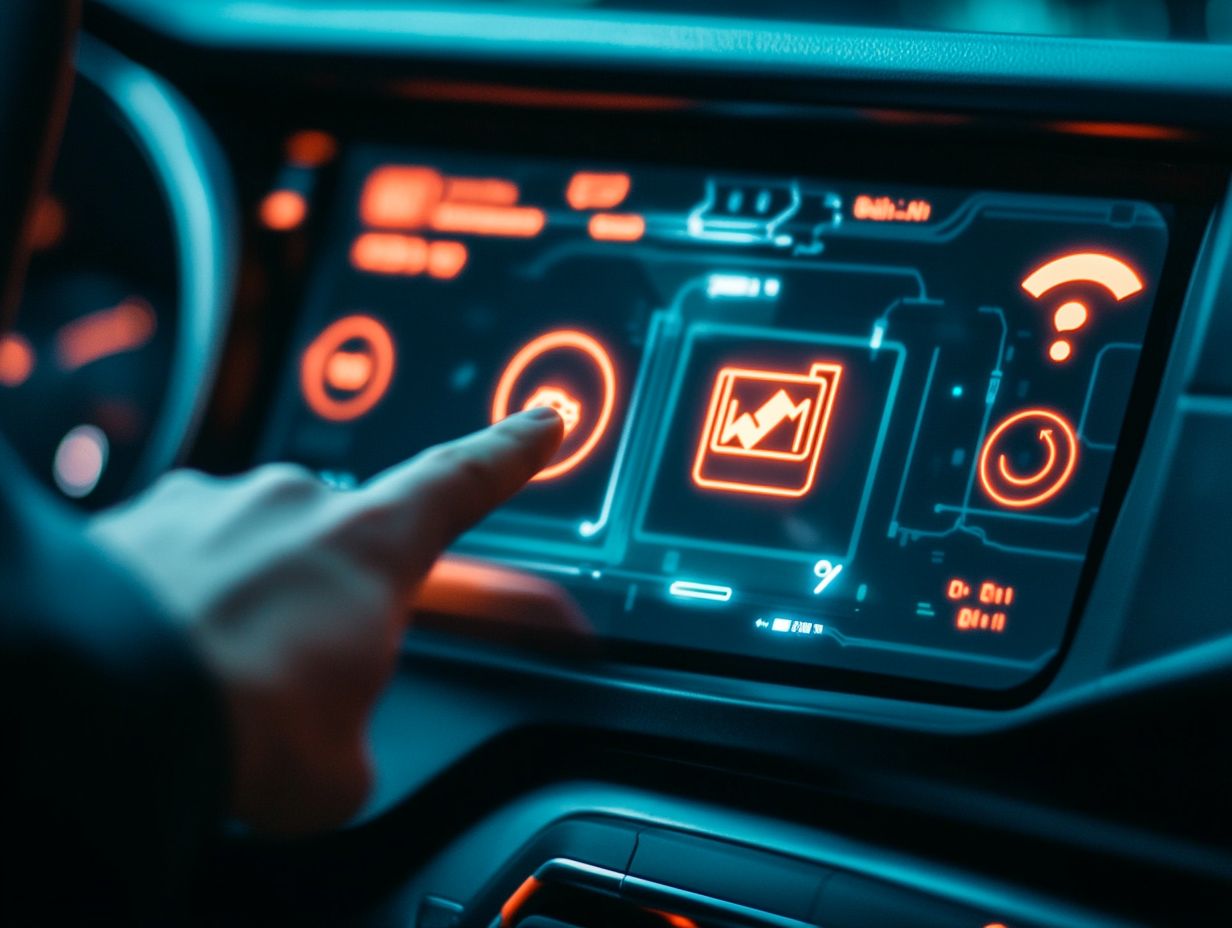What to Do if Your EV Shows Warning Lights
When you re driving your electric vehicle (EV), spotting warning lights can be alarming! But understanding what they mean is vital for your safety and your vehicle s health.
This guide meticulously outlines the common warning lights you might encounter, what each one signifies, and the prompt actions you should consider when they illuminate. This guide also covers important maintenance tips, repair options, and how to expertly navigate your warranty and insurance coverage.
Stay ahead of the curve and keep your EV running smoothly!
Contents
- Key Takeaways:
- Understanding EV Warning Lights
- Actions to Take When Warning Lights Appear
- Maintenance and Repairs for EV Warning Lights
- Dealing with Warranty and Insurance Coverage
- Frequently Asked Questions
- What should I do if my EV shows warning lights?
- Is it safe to continue driving if my EV’s warning lights are on?
- What are some common warning lights that may appear on my EV?
- Do I need to take my EV to a dealership if a warning light comes on?
- Can I reset the warning lights on my EV on my own?
- How can I prevent warning lights from coming on in my EV?
Key Takeaways:

- Be familiar with common EV warning lights and their meanings to quickly identify potential issues.
- In case of warning lights, prioritize safety by taking immediate steps and seeking professional help.
- Regular maintenance can prevent warning light triggers, but repairs and replacements may be covered by warranty or insurance.
Understanding EV Warning Lights
Understanding EV warning lights is essential for you as an electric vehicle (EV) owner, especially if you drive models like the MG ZS EV. Those warning lights on your dashboard are not just flashy distractions; they are critical indicators of how your vehicle is working, alerting you to potential issues that might need your immediate attention.
Recognizing what each warning icon means can save you from allowing minor problems to snowball into major faults. This understanding ensures both your safety and your vehicle’s optimal performance.
Learning about your vehicle manual will help you understand common faults and their meanings, which can significantly enhance your vehicle maintenance and service practices.
Common Warning Lights and Their Meanings
Common warning lights on your electric vehicle’s dashboard serve as vital indicators of various operational issues, including battery charge levels, brake issues, and power steering problems. Each warning light carries a specific meaning, and knowing these helps ensure safe and efficient vehicle operation.
Take the battery warning light, for example. It s crucial because it alerts you to low energy levels or potential charging problems factors that could significantly impact your vehicle’s range and efficiency.
Similarly, the lights indicating brake or traction control problems should never be brushed aside, as they could compromise your safety while driving. Understanding these signals is not just about preventing breakdowns and avoiding costly repairs; it s also about enhancing your overall driving performance.
For EV owners like yourself, familiarizing yourself with these indicators is essential, especially when considering how your driving style can influence energy consumption and the longevity of your vehicle’s components.
Actions to Take When Warning Lights Appear
When EV warning lights illuminate on your dashboard, it s crucial to act swiftly to safeguard both your safety and the integrity of your vehicle. Overlooking these warning signals can result in significant vehicle issues, jeopardizing performance and safety.
Start by deciphering the meaning of each warning light. Then respond appropriately, whether that involves pulling over to inspect your vehicle or reaching out for emergency assistance to address the situation effectively.
Immediate Steps to Ensure Safety

When those warning lights start flashing, signaling potential electrical faults, act swiftly to protect yourself and others on the road. Find a safe spot to pull over and turn off your vehicle to avoid further complications.
Take a moment to assess the situation. Consult your vehicle manual, which will guide you on whether to call for emergency assistance or if it s feasible to drive to a nearby service station.
Once you ve ensured you re in a secure location, keep an eye out for any additional warning lights that might shed light on the issue. If the manual flags a serious problem, don t hesitate! Reach out to roadside assistance immediately.
Maintaining a safe distance from other vehicles enhances your safety, especially if staying put isn t an option. Regular inspections and thorough diagnostics are key to effective vehicle maintenance. They help prevent unexpected scenarios while saving you time and extending your vehicle’s lifespan.
Following this protocol not only safeguards your well-being but also contributes positively to the overall safety of the roadways.
Next Steps for Identifying and Addressing the Issue
After ensuring your safety when those warning lights illuminate on your EV dashboard, the next step is to effectively identify and address the underlying issues. You can start with a quick vehicle inspection or run diagnostics to pinpoint problems related to the battery system, charging issues, or other electrical systems.
Understanding what each warning light signifies is crucial for informed troubleshooting. Consult your vehicle s manual to decode the specific alerts, especially those indicating charging problems that might arise from worn-out batteries or faulty connections.
Regular maintenance checks focusing on battery terminals and the integrity of charging cables can prevent these issues from escalating. Using diagnostic tools provides deeper insights into your vehicle’s systems, revealing any irregularities before they become critical.
By adhering to a consistent maintenance schedule, you prolong battery life and enhance the overall performance of your vehicle.
Maintenance and Repairs for EV Warning Lights
Regular maintenance and timely repairs are essential for electric vehicles, especially when it comes to those warning lights on the dashboard that indicate potential issues with the electrical systems.
By following a proactive service schedule, you can prevent common faults and ensure your EV operates seamlessly, ultimately enhancing its longevity and performance.
Regular Maintenance to Prevent Issues
Regular maintenance is essential for your electric vehicle to avoid issues that might trigger those pesky warning lights. It s all about keeping tabs on battery temperature and ensuring optimal energy consumption. By sticking to a structured maintenance routine and seeking professional vehicle service, you mitigate risks and boost your vehicle’s operational efficiency.
Key tasks to consider include:
- Checking tire pressure
- Inspecting brake systems
- Updating software
These tasks are vital for maintaining performance. Regularly assessing the battery’s condition and temperature management systems is crucial, as overheating or excessive cooling can severely impact longevity. Monitoring your energy consumption patterns also helps spot any irregularities that could hint at underlying issues.
Engaging experienced technicians for periodic check-ups ensures that everything is functioning as it should, leading to a safer and more reliable driving experience.
Repairs and Replacements for Warning Light Triggers

Addressing repairs and replacements for components that trigger warning lights is crucial for maintaining your vehicle’s safety. Ignoring these alerts can cause bigger problems later, ultimately impacting your driving safety and overall performance.
When you see the check engine light flickering, it often signals that various systems need inspection, such as the exhaust (the system that removes waste gases from the engine) or the fuel injection system (which delivers fuel to the engine). Common fixes might include:
- Replacing faulty oxygen sensors
- Ensuring optimal fuel delivery
- Addressing ignition system failures
Issues with wiring or connectors need immediate attention to prevent further electrical faults. Don’t ignore warning lights acting quickly can save you from costly repairs! Schedule regular check-ups and timely interventions to enhance your vehicle’s reliability and your overall driving experience.
Dealing with Warranty and Insurance Coverage
Navigating warranty and insurance coverage is essential for electric vehicle owners, particularly when dealing with repairs prompted by warning lights.
Grasping the specifics of your warranty and the scope of your insurance coverage can profoundly influence your financial landscape for servicing and repairs. This understanding shields you from unexpected expenses and potential complications, allowing for a seamless ownership experience.
What to Expect in Terms of Coverage
When considering coverage for electric vehicles, knowing what to expect is important. The coverage can vary significantly based on the manufacturer and the specific terms of the warranty, especially regarding repairs related to the EV system or battery components.
Many EV manufacturers provide tailored coverage packages that go beyond the standard warranty, often including roadside assistance and services for unique electronic components. This added layer of protection offers you peace of mind, especially given the distinct maintenance needs of electric vehicles compared to traditional ones.
Be mindful of common exclusions like wear-and-tear items and damages from misuse. By thoroughly reviewing the warranty documentation and exploring insurance options, you can effectively navigate potential out-of-pocket expenses and make informed decisions about repairs and services, ensuring your vehicle remains in peak condition.
Frequently Asked Questions
What should I do if my EV shows warning lights?

If your EV’s warning lights come on, the first thing you should do is safely pull over to the side of the road and turn off the vehicle. This will prevent any potential damage and ensure your safety.
Is it safe to continue driving if my EV’s warning lights are on?
No, it is not safe to continue driving if your EV’s warning lights are on. These lights indicate a potential problem that could lead to further damage or a breakdown. Address this issue immediately!
What are some common warning lights that may appear on my EV?
- Battery light
- Check engine light
- Tire pressure warning light
- Brake system warning light
It’s important to familiarize yourself with these lights and their meanings to be prepared for potential issues.
Do I need to take my EV to a dealership if a warning light comes on?
The severity of the warning light determines your next steps. For minor issues, like a low tire pressure warning, you may handle it yourself. However, for more serious warnings, it’s best to take your EV to a dealership or certified mechanic for proper diagnosis and repair.
Can I reset the warning lights on my EV on my own?
Yes, most EVs have a reset button or option in the settings menu that allows you to reset warning lights. However, addressing the underlying issue that caused the warning light to come on is crucial.
How can I prevent warning lights from coming on in my EV?
To prevent warning lights in your EV, regular maintenance is key.
Follow the schedule for keeping your car in good shape. Check tire pressure and fluid levels, and fix issues immediately to avoid further problems.





